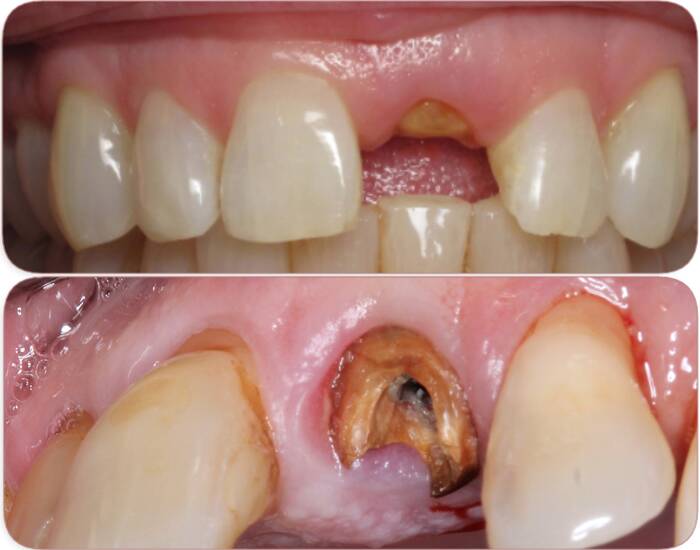Tooth broken at gum line, what treatment? Remove or repair? Why do teeth break in this way? How to avoid this kind of problem? And finally, what to do when a tooth root remains in the gum?
I. Why Do Teeth Break?
Many causes can be at the origin of a broken tooth. This phenomenon is very common, much more so than one would think.
A shock or trauma can cause one or more teeth to break. This can occur following an accident (car, fall…) or after the practice of a sports activity like boxing.
Dental infections, such as cavities, can also cause a tooth to break. Tooth decay is the sign of a spread of bacteria in the mouth, affecting the health of the teeth.
These bacteria and germs can eventually weaken the structure of the tooth and make it more fragile.
Besides cavities, other infections can cause teeth to break. Plaque that has developed into tartar can also weaken tooth enamel.
Certain behaviors such as bruxism are also responsible for tooth fragility. By clenching your jaws or grinding your teeth, you make them more sensitive.
The last cause is age. As time passes, teeth lose their strength and break more easily.
Not to mention the devitalization of the tooth which also causes dental fragility. This can occur as a result of a cavity, but also of other infections. The tooth becomes devitalized when it is no longer irrigated by blood vessels.
It often crumbles, before breaking completely.
II. Tooth Broken at Gum line, Treatments?
Solutions exist in cases where the tooth is broken at the gum line. In these cases, it is under the level of the gum or the bone that the fracture takes place.
One solution is a laser gingivectomy. This operation is mainly used when the tooth is broken at the gum level. Laser is increasingly used in orthodontics. It allows more meticulous work and an easier release of the broken tooth.
Laser gingivectomy is a way to free the tooth from the gum, for a better repair of the tooth.
If the fracture is too deep, the dentist will create a restoration area at least 3 mm from the bone level.
With the help of a scalpel or a laser, he or she can repair the broken tooth and probably place a crown. This will solidify the tooth.
Repairing a broken tooth that is flush with the gums also depends on the condition of the tooth. If the dentist finds that the pulp of the tooth is not damaged, then he or she will be able to glue the piece of the tooth back together. For this reason, the broken tooth should be kept in milk, for example, until your appointment with the dentist.
In cases of a cracked or fractured root, it may also be necessary to extract the entire tooth.
III. Tooth Root Left in the Gum, what to Do?
There are cases of broken teeth, but with the root remaining inside the gum. Dentists believe that it is possible to reconstruct the tooth with composite materials. But only after devitalizing the tooth, especially in cases where the fracture has affected the pulp.
A ceramic crown, for example, can be placed. It will solidify the tooth while giving it a natural look.
Now, only the dentist can decide what is the best thing to do. If the broken tooth was infected, the dentist may choose to extract the root, to avoid any risk of infection.
An appointment with the dentist is the only way to know what to do.
IV. Tips to Avoid the Problem of Tooth Broken Below Gum Line
Preventive measures can be taken to avoid breaking teeth. It happens more frequently to children than to adults, but adults are also affected.
Children most often break their teeth while playing. It is important to ensure the safety of the places they play, such as swimming pools.
Good oral hygiene should also be taught to them. Teeth can also break due to cavities or other dental infections. It is important to teach toddlers to brush their teeth at least twice a day and always before bedtime. And teach them how to brush properly.
For adults, tooth wear is inevitable over time. Nevertheless, good dental hygiene helps to preserve teeth for longer. In addition, it is important to see your dentist at least once a year. This follow-up allows for to detection of problems and to prevent infections.
It is also necessary, for those who practice contact sports, to protect themselves well. Mountain bikers or combat sports enthusiasts should wear helmets or personalized dental-maxillary protection.
This type of mouthguard is custom-made and fits easily in the mouth. It prevents impact on the back teeth, soft tissue, and front teeth.
Useful Links:
Analysis of factors associated with cracked teeth
How to Fix Overcrowding Teeth?
What Can You Do Instead of Dental Implants?
Tooth and Ear Pain on the Same Side, What to Do?

